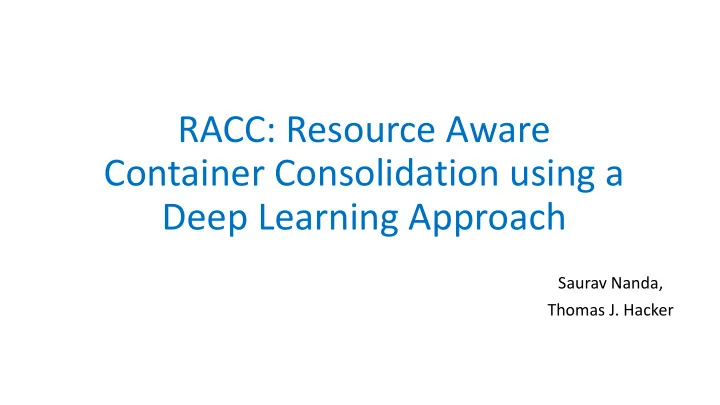

RACC: Resource Aware Container Consolidation using a Deep Learning Approach Saurav Nanda, Thomas J. Hacker
Introduction- Container Packaged Code + Config + Dependencies Lightweight than VM Secure – Default isolation Example: Docker Image FROM debian:stretch-slim ENV NGINX_VERSION 1.15.11-1~stretch ENV NJS_VERSION 1.15.11.0.3.0-1~stretch RUN set -x \ && apt-get update \ && apt-get install -y gnupg1 apt-transport-https EXPOSE 80 CMD ["nginx", "-g", "daemon off;"]
Introduction – Resource Optimization CaaS (Container as a Service) – pay-as-you-go Diverse Resource demands CPU Intensive, Memory Intensive, I/O Intensive, Network Intensive Multi-dimensional bin packing – NP Hard Heuristics based solutions – First Fit, Best Fit, First Fit decreasing Avoid resource fragmentation and over allocation Theoretical Model – Takes 30 min for 15 nodes Deep Learning based Solution – Fit-for-Packing
Example: Container Scheduler Containers
Why pack jobs? Machine: CPU cores = 36 , Memory = 7GB, Network Bandwidth = 6Gbps Job1 - Mappers – 18, Reducers – 3 1 Mapper: 2 GPU, 4GB Memory 1 Reducer: 2 Gbps network Job2 - Mappers – 6, Reducers – 3 1 Mapper: 6 GPU, 2GB Memory 1 Reducer: 2 Gbps network Job3 - Mappers – 6, Reducers – 3 1 Mapper: 6 GPU, 2GB Memory 1 Reducer: 2 Gbps network
Scheduling Framework Adaptive learning of resource requirement of job(Jr) Monitoring of available resources (Mr)
Constraints: task schedule & resource allocation Minimize makespan => Maximize the container consolidation i – machine, efficiency j - container, t – discrete time, α - resource unit, Resource Usage on machine <= D – Demand of each capacity container, Should not exceed maximum Ø – 1 if container j is requirement allocated to machine i at time t To avoid preemption – for simplicity A- allocated JCT – Job completion J duration – total job execution time at time container j Job j’s finish time Most prominent resource
Results Job Slowdown = Tcompletion / Texpected
Results Training Accuracy – 82.01%, Testing accuracy – 82.93%
Thoughts CRIU - Checkpoint/Restore In Userspace Freeze the running application for live migration. Deep or shallow neural network? (25 neurons) Comparison with fair scheduling Dependency between jobs, the locality issue of machines.
Questions?
Recommend
More recommend